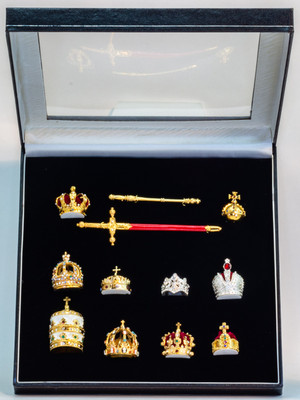
This 2nd set of two World collectors sets contains the following items:
THE CROWN OF THE NETHERLANDS: Made for William II, of silver gilt, set with imitation stones and pearls.
THE DUTCH ROYAL SCEPTRE: Made of silver gilt, the sceptre has a stylised leaf design at the top, supported by a small orb and cross.
THE DUTCH ROYAL ORB: The orb is made of silver gilt. It bears the classic form of a globe with imitation jewelled meridian and bands, surmounted by a cross.
THE DUTCH SWORD OF STATE: The hilt has a gilded grip (or handle), set with imitation stones, and the scabbard is covered with crimson velvet.
THE CROWN OF NAPOLEON: Napoleon Bonaparte was crowned on 18th May 1804 with a wreath. However this crown covered with precious cameos and intaglios was also made to be on show at his coronation.
THE TIARA OF EMPRESS JOSEPHINE: Reputed to have been made specially for Empress Josephine, first wife of Napoleon Bonaparte.
THE CROWN OF LOUIS XV: In 1887 the Crown Jewels of France were sold at auction and although most pieces were distributed world wide, this crown was retained.
THE IMPERIAL CROWN OF RUSSIA: Commissioned for the Coronation of Catherine II in 1762, it is set with thousands of diamonds and a large Spinel.
THE PAPAL TRIPLE TIARA: Created in 1804 by Emperor Napoleon Bonaparte as a gift for Pope Pius IV, who had agreed to attend his Coronation.
THE IMPERIAL CROWN OF AUSTRIA: Also known as 'THE GERMAN REICHSKRONE'. Made in 1602 for Rudolf II. On the
demise of the Holy Roman Empire in 1806 it became known as The Crown of The Emperor of Austria.
THE CROWN OF THE HOLY ROMAN EMPEROR: Also known as 'The Crown of Charlemagne'. Believed to have been made for the Coronation of Emperor Otto I in 962.
THE CROWN OF SWEDEN: Eric became King of Sweden in 1560 and had this wonderful new crown made for his coronation.
THE CROWN OF BOHEMIA: With this crown Wenceslas I was crowned with his wife Kunhuty in 1228, it is one of the oldest and finest examples of the mediaeval Lily crown to have survived.
















